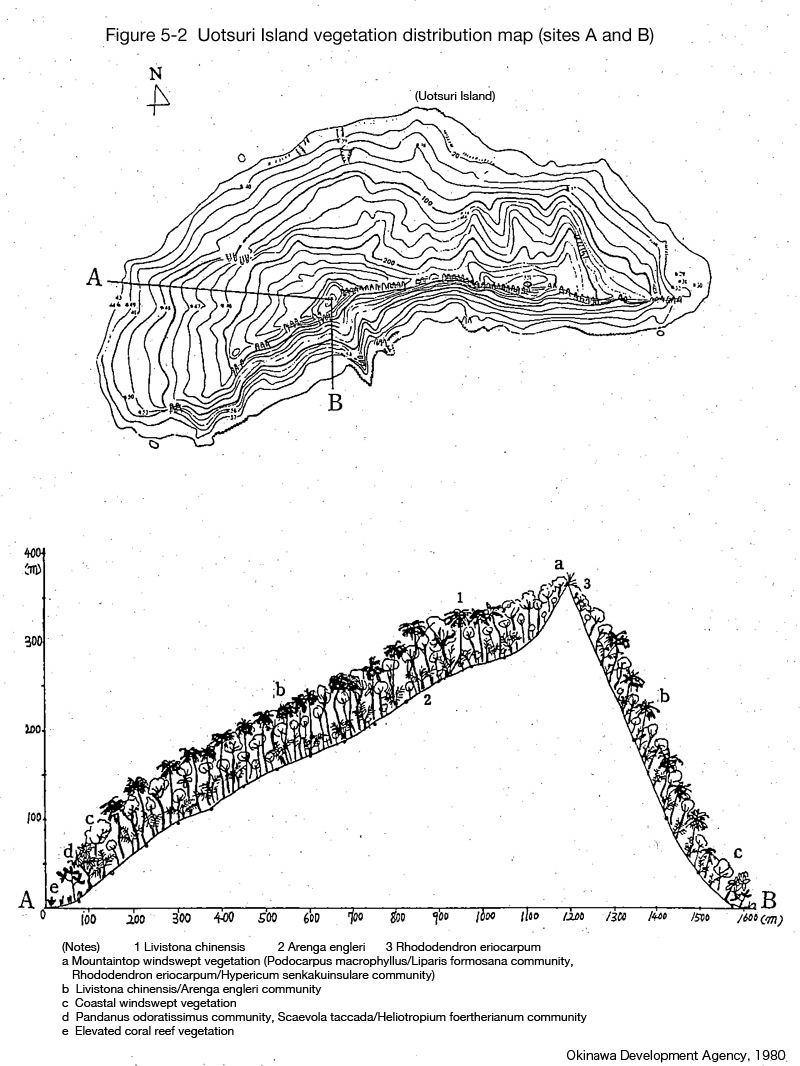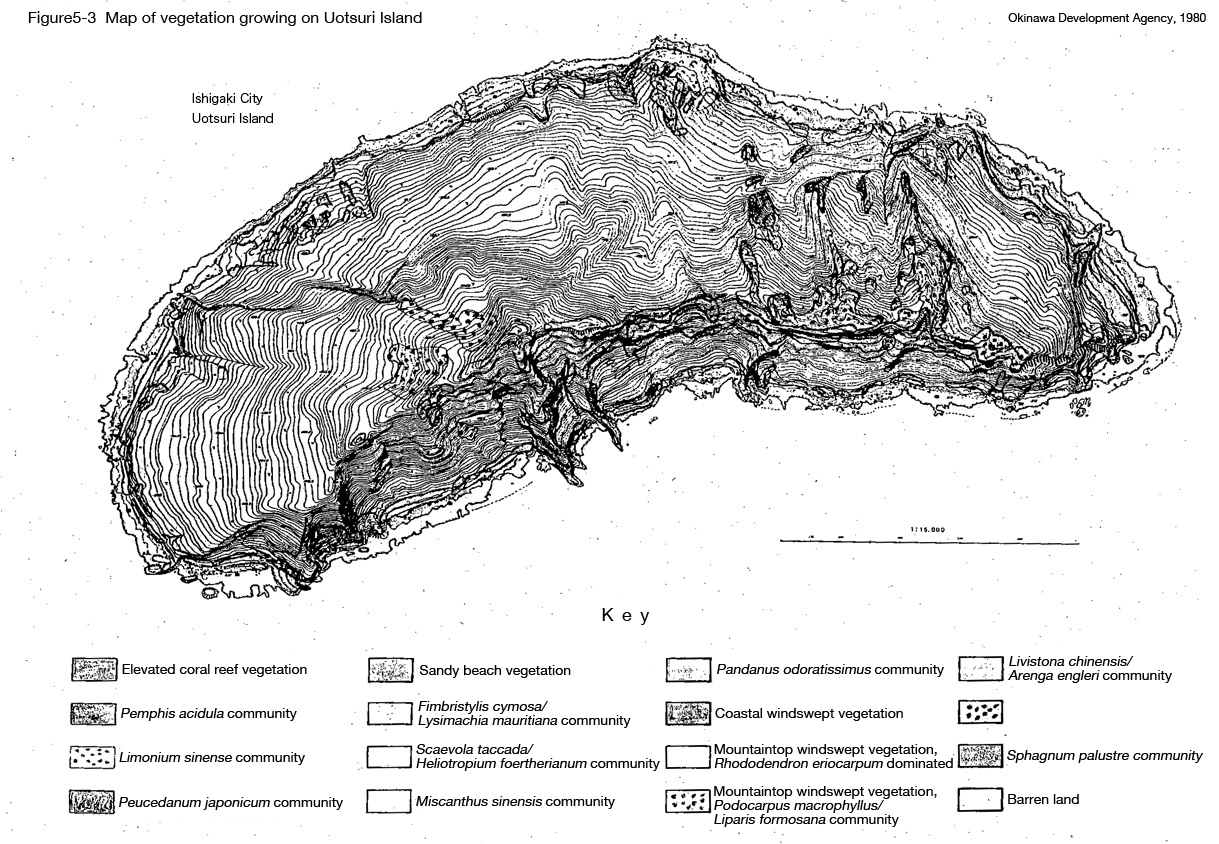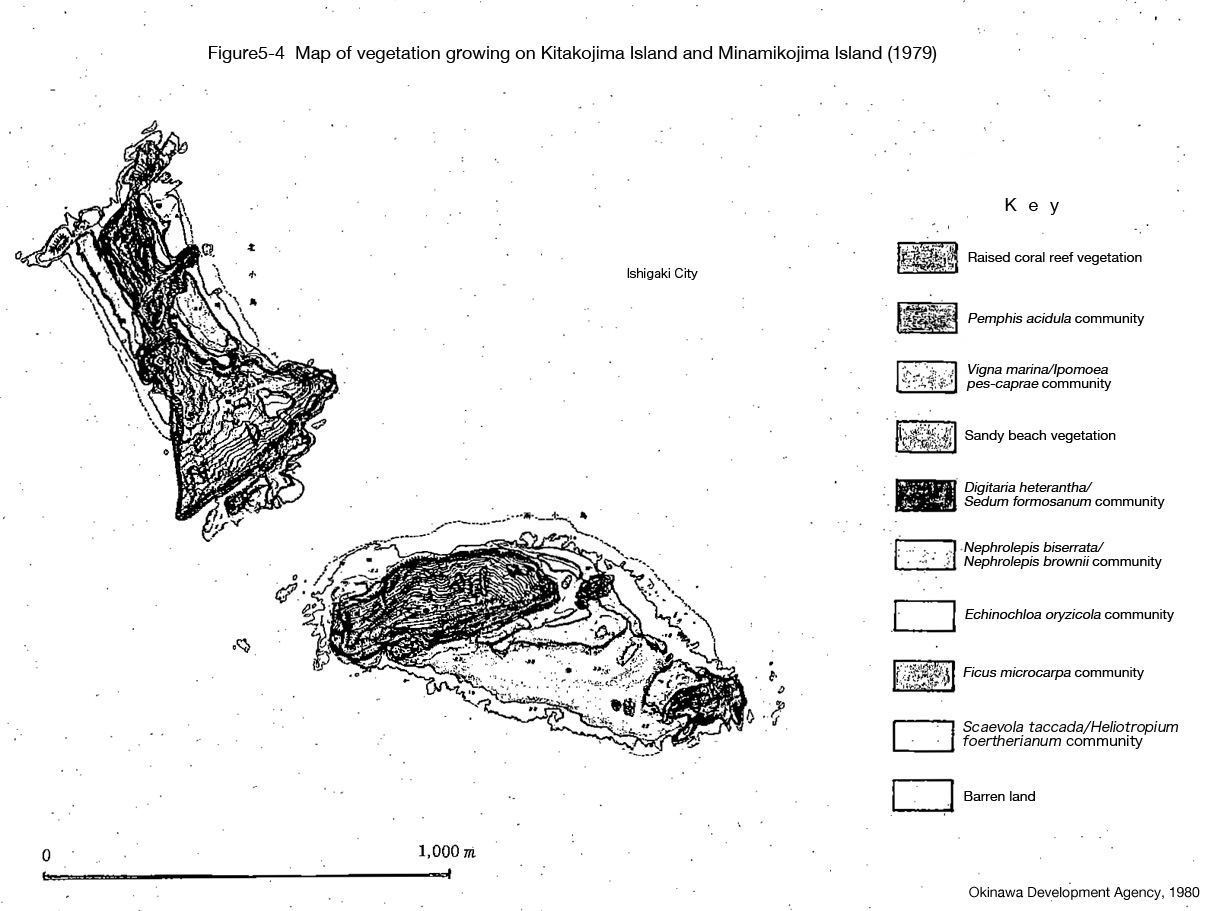Surveys following Okinawa's reversion to Japan (1979: Okinawa Development Agency)
-
Feb 17, 2015
The Japanese Government's Okinawa Development Agency conducted an academic survey in 1979. Organisms were surveyed between May 28 and June 7 of 1979, resulting in one report on land animals focused on terrestrial vertebrates and large soil animals, a second report on land animals focused on mammals, a report on aquatic animals (including both ocean and inland water dwellers), and a report on plants.
(1) Land animals survey (1: focusing on terrestrial vertebrates and large soil animals)
This report was conducted by Ikehara Sadao and Abe Takuya (University of the Ryukyus Faculty of Science), identifying 3 orders, 3 phyla, and 4 species of mammal, 10 orders, 18 phyla, and 32 species of bird, 1 order, 3 phyla and 6 species of birds. It also observed the following species in the Senkaku Islands for the first time. (Ref. 2)
- Mammals: goats, 1 species of mole, 1 species of striped field mouse
- Birds: Baillon's crake, common moorhen, grey-tailed tattler, lesser sand plover, lesser cuckoo, and grey nightjar, which were all observed on Uotsuri Island.
The report also adds the following habitats to the existing list.
- Minamikojima Island: black rat, Japanese wood pigeon, tree sparrow, Japanese white-eye
- Uotsuri Island: little egret
It was later understood that the mole species was a new and indigenous species, which in 1991 was recorded as the senkaku mogura (Mogera uchidai), or Senkaku mole. (Ref. 1) The report argues that the discovery of the Senkaku mole and the species of striped field mouse were extremely valuable to the study of zoogeography. The report notes that the population of seabirds on Minamikojima Island appeared to be declining, and while this survey did not manage to observe any short-tailed albatrosses, it did discover for the first time a flourishing population (about 250) of greater crested terns on Kitakojima Island. The report also mentioned that 4 goats were residing in a former katsuobushi (dried bonito fish flakes) factory on Uotsuri Island, and if left to their own devices, they could cause a severe impact on the local ecology. In the large soil animal study, 8 new land snail species were identified, as well as 19 ant species. Isopods were the most common form of soil animal, a tendency which was most pronounced in the coastal vegetation region. Not only does this study find that a large number of animals interesting from a biogeographical perspective are distributed throughout the islands, it also says that there may yet remain a number of new and previously unrecorded species. (Ref. 2)
(2) Land animals survey (2: focusing on mammals)
Shiraishi Satoshi (Kyushu University Faculty of Agriculture) and Arai Shusei (Kyushu University Graduate School of Agriculture) conducted this survey, looking at mammals, birds, reptiles, amphibians, insects, myriapods, crustaceans, and freshwater and land snails. This survey collected a sample of a previously unrecorded mole (one individual, female) and the second instance of a species of Apodemus agrarius (striped field mouse) that was first discovered in the 1970 cooperative survey conducted by Kyushu University and Nagasaki University (two individuals, female). Although this mole resembled the Mogera insularis of Taiwan, it had a different number of teeth as well as a moderate amount of other clearly different traits. The mouse species was also similar to a Taiwanese species, but with clear differences being recognized, and the report says that names for these two species should be decided in the future. As for reptiles, a subspecies of yunnan madara (dinodon)--a distinct species from akamadara (Dinodon rufozonatum)--was collected, and the authors of the report mentioned their intention to give the new subspecies a provisional Japanese name of senkaku madara (Dinodon nigrofasciatus). The report argues for proactive measures for preserving the natural state of the Senkaku Islands, which it describes as a treasure trove of organisms, while also raising the issue of eliminating the goats. (Ref. 3)
(3) Aquatic animals survey (coastal and freshwater animals) This survey was conducted by Nishijima Shinsho and Yoshino Tetsuo (University of the Ryukyus Faculty of Science), and includes the first report on littoral (coastal) fishes in the Senkaku Islands. After describing the coastal environment of Uotsuri Island, Kitakojima Island, and Minamikojima Island, the report goes on to list 38 families, 82 genera, and 155 species of coastal fish that were identified around Uotsuri Island and Minamikojima Island, with no species identified as endemic to the Senkakus. The report mentions the fish species of brownbanded bamboo shark and Chaetodon wiebeli as noteworthy, with the brownbanded bamboo shark being identified near Japanese waters for the first time. Although there was no reliable record of Chaetodon wiebeli outside of Kochi Prefecture, Nishijima and Yoshino report that it was observed commonly during this survey. (Ref. 4)
There are few productive species, which is estimated to be linked to overall poor development of reef-building coral. On the other hand, the report argues that the fast currents and strong waves near the Senkaku Islands are also linked, and that the prevalent large fish with strong swimming ability are generally the same species that can be seen at open rocky beaches. (Ref. 4)
In all, 40 families, 68 genera, and 127 species of mollusk were identified, with 78 species from Uotsuri Island (of which 64 species were newly recorded) and 96 species from Minamikojima Island (of which 70 were newly recorded). For the Senkaku Islands as a whole, there were 41 newly recorded species, but with the majority of the collected species being ones also found in the Ryukyu Islands, the report argues, the overall ecology of the Senkaku islands has significant overlap with that of the Ryukyu Islands. The report argues that the fact that the biogeographically interesting species unihizaragai (Acanthopleura spinosa) is, in Japan, limited to the Senkaku Islands, and the fact that although chosen sazae (Turbo argyrostomus) is commonly found in the Ryukyu Islands it was not identified in the Senkakus, while many samples of marusazae (Turbo setosus) were collected--as well as the fact that many examples of hachijo dakara (Cypraea mauritiana), which commonly resides in the margins of coral reefs in the Ryukyu Islands, were observed in tide pools on Uotsuri Island and Minamikojima Island--show that the tide pool habitats seen in the elevated coral reef seashore of the Senkaku Islands corresponds to the reef margin area in living coral of the Ryukyu Islands, as a habitat supporting life. (Ref. 4)
In the survey of Japanese spiny lobster, the majority of samples collected in Uotsuri Island and Minamikojima Island were the species of pronghorn spiny lobster common in the coral facing the turbulent waves of open sea, and the results of the survey estimates that many pronghorn spiny lobsters reside on the edge of the elevated coral reef shore. (Ref. 4)
For inland water resident animals, while togenashi numaebi (Caridina typus), sakishima numaebi (Caridina prashadi), and giant mottled eels live swimming in the ocean while young and may be distributed over a wide area, iboaya kawanina (Tarebia granifera) and miyazaki sawagani (Geothelphusa miyazakii) are purely freshwater creatures, and their distribution across the Senkaku Islands is thought to be related to the history of the islands, as well as very interesting from a biogeological perspective. (Ref. 4)
(4) Flora survey
This survey was conducted by Niiro Yoshima and Shinjo Kazuharu (University of the Ryukyus Faculty of Education) at a total of 131 sites (68 sites on Uotsuri Island, 40 sites on Minamikojima Island, and 23 sites on Kitakojima Island). The results of the survey are summarized as follows, for each island. (Ref. 5)
Uotsuri Island: 66 species of fern, 1 species of gymnosperm, and 272 species of flowering plant, with 20 of them being newly identified in that distribution, of which senkaku tororoaoi (Abelmoschus moschatus var. betulifolius) was newly recorded in the Ryukyu Islands. Communities that were observed on Uotsuri Island, in phytosociological terms, were windswept mountaintop vegetation (the Podocarpus macrophyllus/Liparis formosana community and the Rhaphiolepis umbellata/Liriope muscari or Rhododendron eriocarpum/Hypericum senkakuinsulare community), inclined high forest (the Livistona chinensis/Arenga engleri community), lowland windswept shrub forest (the Ficus microcarpa/Planchonella obovata community), seashore plants (the Scaevola taccada/Heliotropium foertherianum community, Lotus taitungensis community, Blutaparon wrightii community, Pemphis acidula community, Hedyotis strigulosa/Zoysia pacifica community, Miscanthus condensatus community, Sphagnum palustre community, Limonium sinense community, Vitex rotundifolia community, Euphorbia chamissonis community, Fimbristylis cymosa/Lysimachia mauritiana community, and Peucedanum japonicum/Sedum formosanum community). This report also mentions the goats, saying that they consume 24 different plant species, based on traces of destruction due to trampling and eating that were discovered in mantle communities and forest floor plants. (Ref. 5
Minamikojima Island: With only 6 species of fern and 55 species of flowering plants, communities of grasses were the majority of native plants, with the report listing elevated coral reef vegetation (the Zoysia pacifica/Hedyotis strigulosa community, Pemphis acidula community, Artemisia chinensis community, Blutaparon wrightii community, and Vigna marina/Ipomoea pes-caprae community), sandy beach vegetation (the Lysimachia mauritiana/Calystegia soldanella community), and rocky hill vegetation (the Digitaria heterantha/Sedum Formosanum community, Nephrolepis biserrata community, Nephrolepis brownii community, and Ficus microcarpa community). (Ref. 5)
Kitakojima Island: This island had the sparsest plant life, with only 3 species of fern and 33 species of flowering plant, with the most developed vegetation being grasses on the rocky hills, and elevated coral reef vegetation (the Blutaparon wrightii community and Heliotropium foertherianum community) and rocky hill vegetation (the Digitaria heterantha/Sedum formosanum community and Echinochloa oryzicola community) also being listed. (Ref. 5)
Note that the results of the survey were summarized on maps of vegetation growing on Uotsuri Island, Kitakojima Island, and Minamikojima Island and a vegetation distribution map for Uotsuri Island showing altitude distribution of vegetation by type. (Ref. 5)
Source (Above, Middle, Below) Okinawa Development Agency, Senkaku Shoto chosa hokokusho: Gakujutsu chosahen (Report on the Senkaku Islands Survey: Academic Survey), Summary Edition (Okinawa Development Agency, 1980).
Translated by OPRF

Ref.2 :Ikehara Sadao and Abe Takuya, Senkaku Shoto chosa hokokusho: Gakujutsu chosahen (Report on the Senkaku Islands Survey: Academic Survey), Chapter 1 (Okinawa Development Agency, 1980).
Ref.3 :Shiraishi Satoshi and Arai Shusei, Senkaku Shoto chosa hokokusho: Gakujutsu chosahen (Report on the Senkaku Islands Survey: Academic Survey), Chapter 2 (Okinawa Development Agency, 1980).
Ref.4 :Nishijima Shinsho and Yoshino Tetsuo, Senkaku Shoto chosa hokokusho: Gakujutsu chosahen (Report on the Senkaku Islands Survey: Academic Survey), Chapter 3 (Okinawa Development Agency, 1980).
Ref.5 :Niiro Yoshima and Shinjo Kazuharu, Senkaku Shoto chosa hokokusho: Gakujutsu chosahen (Report on the Senkaku Islands Survey: Academic Survey), Chapter 5 (Okinawa Development Agency, 1980).

→


 RSS
RSS



Info Library
Japan's Island Territories
Senkaku Islands Facts & Figures
Takeshima Facts & Figures
Northern Territories Facts & Figures